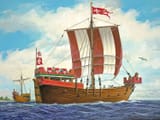Search Results
ID: PBhKDqrt/qst/6259847#6279300
7/23/2025, 12:18:37 PM
The Armentic Isles are a collection of three to four great islands and many lesser ones scattered within the Armentic Sea, which itself is an inland sea of the great Elentic Ocean.
The three islands in the hands of the Svengalians are Alfander, Ölfland, and Rosand. The Toldmarkers have the Island of Vindholm, which is the smallest of the four and isn't counted as such by the Svengalians.
In the very distant past, these islands were used by the Elves in their pilgrimages up north, though they withdrew as their ships got more advanced and they moved further north. After them came the Norse humans and dwarves. The Vikings of the ninth, tenth, and even eleventh centuries used them as bases for their raiding and trading activities, mostly focused on the rivers of Pelechia.
There has, in recent history, been much to do with these islands; the kings of Toldmark, rich from their ability to collect tolls through the straits, see the islands as a strategic advantage in controlling trade routes. Conversely, the Kings of Svengalia see their islands as the springboard to gain hegemony of the sea as well as to regain Sparland, which had been left to Knut, a bastard son of a Svengalian king.
There was something deeper to all of this as well; according to their official lineages, all the northern kings descend from the legendary Alfarin Dwarffriend, the High King of the Northern tribes. Who rescued a Drawen king and united the tribes for a war against the giants before he died in battle, when his three children divided the realm amongst themselves. They would in turn be the beginning of the royal lineage of Norddalr, Svengalia, and Toldmark.
There had been attempts to bring back this High Kingship, of course, but nobody seemed to agree on who exactly should be the High King, so the point was rendered rather moot.
The tribes turned into kingdoms, and currently, there seems to be a lull in the conflict. In Toldmark, there was to be an election with the death of King Waldemar. So for now, the Svengalians could retain their control over the isles.
The mercantile league, likewise, had a vested interest in maintaining the current balance of power. Neither the Toldmarkers nor the Svengalians should be too dominant; that would be bad for business. The league prefers a policy of open seas, preferably with as many nations on the coast as possible. This is to avoid or pressure states into giving up tariffs and tolls by threatening to go elsewhere.
But that does beg the question, how does one insert Greifswald into all of this? At the moment, the Greifswalder navy contained about twenty-four ships, most of which were Mithradian-style dromons, and some cogs. It was the assumption that transport could be hired with regular merchant ships. And all in all, you had suspected that you would most likely fight Svengalian longships and cogs.
The three islands in the hands of the Svengalians are Alfander, Ölfland, and Rosand. The Toldmarkers have the Island of Vindholm, which is the smallest of the four and isn't counted as such by the Svengalians.
In the very distant past, these islands were used by the Elves in their pilgrimages up north, though they withdrew as their ships got more advanced and they moved further north. After them came the Norse humans and dwarves. The Vikings of the ninth, tenth, and even eleventh centuries used them as bases for their raiding and trading activities, mostly focused on the rivers of Pelechia.
There has, in recent history, been much to do with these islands; the kings of Toldmark, rich from their ability to collect tolls through the straits, see the islands as a strategic advantage in controlling trade routes. Conversely, the Kings of Svengalia see their islands as the springboard to gain hegemony of the sea as well as to regain Sparland, which had been left to Knut, a bastard son of a Svengalian king.
There was something deeper to all of this as well; according to their official lineages, all the northern kings descend from the legendary Alfarin Dwarffriend, the High King of the Northern tribes. Who rescued a Drawen king and united the tribes for a war against the giants before he died in battle, when his three children divided the realm amongst themselves. They would in turn be the beginning of the royal lineage of Norddalr, Svengalia, and Toldmark.
There had been attempts to bring back this High Kingship, of course, but nobody seemed to agree on who exactly should be the High King, so the point was rendered rather moot.
The tribes turned into kingdoms, and currently, there seems to be a lull in the conflict. In Toldmark, there was to be an election with the death of King Waldemar. So for now, the Svengalians could retain their control over the isles.
The mercantile league, likewise, had a vested interest in maintaining the current balance of power. Neither the Toldmarkers nor the Svengalians should be too dominant; that would be bad for business. The league prefers a policy of open seas, preferably with as many nations on the coast as possible. This is to avoid or pressure states into giving up tariffs and tolls by threatening to go elsewhere.
But that does beg the question, how does one insert Greifswald into all of this? At the moment, the Greifswalder navy contained about twenty-four ships, most of which were Mithradian-style dromons, and some cogs. It was the assumption that transport could be hired with regular merchant ships. And all in all, you had suspected that you would most likely fight Svengalian longships and cogs.
Page 1
